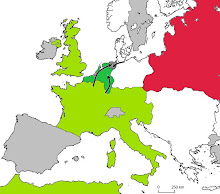 September 1944 was not a good month for the American and British forces in Austria and southern Germany. The allies were unable to retake their port in Trieste, though significant effort by the engineer corps saw Innsbruck become a major supply route, with mountain passes seeing an almost endless stream of trucks travelling north.
September 1944 was not a good month for the American and British forces in Austria and southern Germany. The allies were unable to retake their port in Trieste, though significant effort by the engineer corps saw Innsbruck become a major supply route, with mountain passes seeing an almost endless stream of trucks travelling north.The Americans suffered the worst as a determined German counter attack in the west saw a large force, led by three panzer divisions, strike south from Stuttgart into the foothills of the Alps. Savage fighting badly mauled the American divisions stationed there and by the 18th Ulm and Reutlingen had been retaken by the Germans. Realising their positions were becoming difficult Eisenhower agreed to a withdrawal to the Austrian alps on the 27th, which saw much of western southern Germany back in German hands.
Further east the British and Canadian forces also faced a determined counter attack near Regensberg and Ingolstadt, moving south towards Salzburg. After initial good progress the Germans were stopped on the Danube, with the allied forces putting up fierce resistance. Following the American defeat on the Western flank of the Austro-German salient, the British threw their reserves forward in an attempt to stabilise the situation on the 27th.
A meeting engagement between a British infantry force and a Stug battery intensified as more troops were fed into the fight. Many probing attacks saw British recon units reach the German rear, and run wild through German supply and artillery columns, before their own destruction by a hastily diverted force of Stugs.
Elsewhere, the British reached rifle range of the German artillery, but were driven back by a pioneer counterattack. Casualties among the German artillerymen were heavy, but they refused to break. Despite Goering's promises, the Luftwaffe rarely reached the field, and were easy prey for the British Bofors.

No comments:
Post a Comment